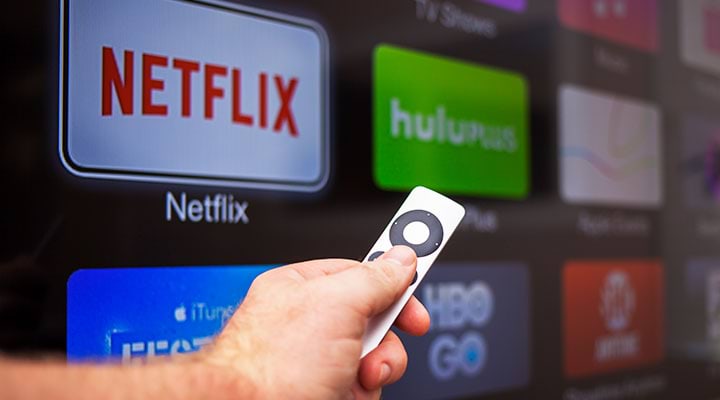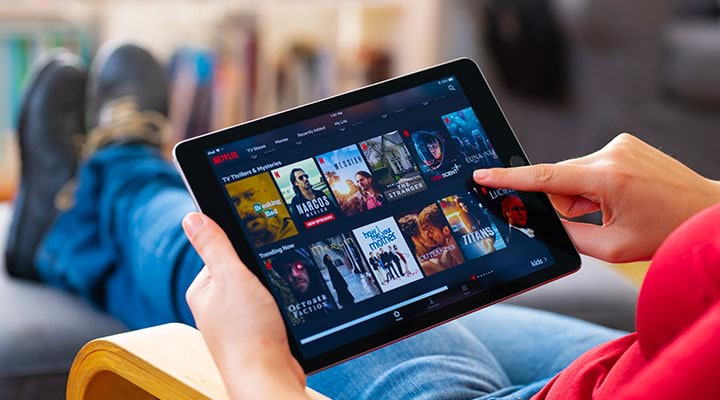What is streaming TV?
How we watch our favorite shows, movies and sports has changed drastically over the past decade. Streaming TV (sometimes referred to as “over the top” TV) is a relatively new way to select and watch media entertainment.

Streaming TV brings together traditional television (think cable, satellite and network television) and digital video (Netflix, YouTube, etc.) under one umbrella. Streaming TV delivers film, TV, live coverage and digital content over the internet, and services can be purchased "a la carte," which is different from the traditional approach of paying a large monthly fee for a massive cable or satellite package, regardless of how many channels you truly watch. With streaming, you might end up with just as many choices — or more — but you’ll most likely pay less for it than you would for cable.
The streaming revolution
Traditional cable and broadcast platforms have long operated as gatekeepers of TV content. The old model let cable or satellite companies bundle their products based on their needs, not necessarily the needs or wants of the consumer. Not only that, but popular viewing trends largely determine what gets put on the schedule, so there’s not as much room for content with a narrower range of appeal.
With streaming TV providers like Netflix, Amazon Prime, and Hulu, all that has changed. You can now bundle your own favorite shows, channels and interests, curating a personalized collection of video content. The choices are almost limitless — you can have streaming only, streaming plus cable or satellite, or streaming plus antenna. What’s more, producers are now able to create more diverse shows for a huge range of viewer categories, not only appealing to the masses. This means there are simply more specialized options out there for just about any interest, style, or demographic group. The control now sits with you, the viewer.
Netflix: The game-changer
When Netflix was introduced in 1997, it was a novel way to rent movies and television shows on DVD through the mail. Today, Netflix has grown into the heavy hitter of ad-free video streaming platforms, with over 90 million subscribers. Netflix forced everyone in the television and cable industry to adapt — not only by providing unlimited shows and movies for one monthly cost, but by driving the creation of hundreds of high-quality, original series and films available only on their platform. Nearly every player in the business now has a streaming service of some sort. For example, HBO, one of the kings of cable television, has now developed a successful standalone streaming service. And new platforms, channels and providers continue to crop up all the time.

What is streaming video on demand?
Streaming video on demand (SVOD) is watching a show or movie through a website or an app at the time of your choosing. In some cases, that app appears as a “channel” on your smart TV or streaming device. Content can be pay-per-view, like renting a new release film that you have 48 hours to stream. Or it can be based on a monthly subscription fee that gets you unlimited access to all the shows and movies available from that particular provider. With streaming, you don’t download the files onto your computer, so you don’t have to worry about storage space or legal issues, and you don’t need an antenna or pricy cable TV package to watch.
What you do need, though, is a high-speed internet connection that can handle the demands of streaming video. To get a good viewing experience without annoying lags, especially if you have multiple people in your home streaming at the same time, we recommend a broadband internet connection with bandwidth of at least 20 Mbps.
Most people will also want to get a streaming device. While it’s true that you can stream straight to your laptop or tablet, if you’re looking to replace cable with streaming services then you’ll most likely want a more convenient, high-definition way to enjoy your media on a larger TV screen.
Finally, to access streaming content, you’ll need at least one membership to a streaming service provider such as Amazon Prime, Hulu, Netflix, HBO Go, or others. In fact, there are over 200 streaming service providers today (and counting). Some have free options (usually with ads), so you can find ways to stream media without paying for it. But if you’ve been paying for a cable TV package, you can sign up for a few paid subscriptions to streaming services and still save a bundle. Paid services grant you full access to a whole catalogue of great content and are often ad-free.
A new world of TV
Never have you had so many choices in how, when and what to watch for video entertainment. Streaming TV is designed to give you greater choice in what you watch, so you get more of what you want and less of what you don’t. If you’re ready to dig in and find out which streaming options might be right for you, try out our TV recommendation tool, which can help you find some of the best deals on TV services. This tool guides you through the selection process for your household and compares the content offered by different service providers. Play around and try out different combinations as you build your own custom TV package. It’s easy and fun!
Discover blog: Streaming TV
Did you find the help you were looking for today?
Support topics





.png)





